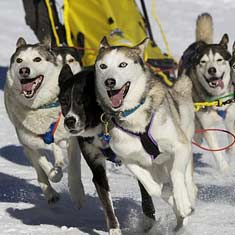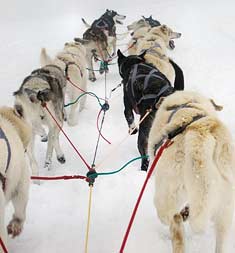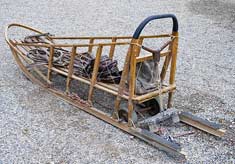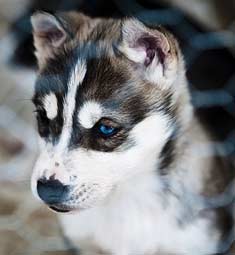The Sport of Dog Sledding
Most of us have seen video, or at least heard of, the Iditarod Trail Sled Dog Race, but that is just (forgive the expression) the tip of the iceberg when it comes to dog sledding. Dog power has been an important part of the culture for centuries for those who live in snowy regions. In some areas, dog sled was the only mode of travel possible before the advent of snowmobiles. Even today, some trappers prefer dog sledding to travel by snowmobile in extreme weather conditions.

The dog team
A team of sled dogs is composed of a lead dog, who is so important as to become literally a member of the musher’s family; point dogs and swing dogs, who run directly behind the leader; team dogs in the middle, and wheel dogs closest to the sled to pull the sled out of deep snow.
The leader of a team may be one dog or two, with two being most commonly in use today. Leaders must be smart, have common sense and the ability to find the trail in bad weather, and they must be willing to take the initiative to steer the rest of the team and set the pace.
The terms “swing” and “point” dogs are often used interchangeably. These are the dogs responsible for guiding the rest of the team through curves, literally swinging the team around a turn.
Team dogs are used strictly for power. A small team may not have any team dogs, while a large team will have many. Depending on the rules of a particular race, a musher may run anywhere from three to 24 dogs.
The calmest dogs on the team are put in the wheel position, just in front of the sled. They must be able to tolerate having a large sled moving around right behind their heels and must be strong enough and steady enough to guide the sled through tight curves.
Racing sled dog breeds
Siberian Huskies, Samoyeds, and Alaskan Malamutes are the breeds most often associated with sledding, but in truth most sled dogs are not purebreds. This isn’t to say they are not carefully bred. Because of the distinctive qualities a sled dog must possess, the ancestry of these dogs is recorded every bit as carefully as the top dog in AKC conformation shows.
The combination of speed, stamina, strength, and knowledge is what is important in a sled dog. Although not recognized as a breed by the American Kennel Club, the type of dog often seen in sled races is called an Alaskan Husky. They are typically faster and smaller than a purebred Siberian Husky.
Keeping the dogs safe
There has been a public outcry against sled racing in recent years because it is not uncommon for a few of the dogs involved in a major competition to die due to the extreme conditions they encounter on the trail. However, organizers of the competitions go to great lengths to ensure the dogs are healthy enough to compete and that they are treated well during the races.
Mushers are required to provide padded harnesses, appropriate food supplies, and veterinary examinations help to keep the dogs in good condition. Race rules also state that a musher must end the race with a minimum number of dogs, assuring that dogs are not simply run to death.
Many mushers place their dogs in booties to prevent foot pad damage from ice and other debris found along the race route.
Mush with PRIDE (Providing Responsible Information on a Dog’s Environment) was founded to enhance the treatment of sled dogs by establishing guidelines for proper sled dog care and treatment. They work with both beginning and established mushers to facilitate communication and education efforts, and to develop improved husbandry and veterinary practices.
In order for a race to be sanctioned by the International Sled Dog Racing Association, the race must meet detailed trail requirements related to safety. Some examples of the safety rules:
- Physical abuse of dogs is prohibited.
- A vet must be on call for all races. Any dog which is unfit or has a contagious disease is disqualified, and in some cases the entire team may be disqualified.
- Performance enhancing drugs including everything from aspirin to steroids are prohibited.
- Each sled must be equipped with a dog bag to carry a dog who becomes too exhausted to complete the race.

Dog Sled Equipment
Depending on the job to be done, sled dogs may pull a variety of types of equipment. A basket sled is the one most commonly used for racing, consisting of a bed that rides several inches above the surface of the snow. A toboggan rides closer to the snow and has a closed bed. Short basket sleds are called sprint sleds, used for races covering from 4 to 25 miles each day for just two or three days. Freight sleds are sturdier than sprint sleds, and may be either a toboggan or a basket design. Freight sleds are used for long distance races covering hundreds or even thousands of miles over several days. Both sprint sleds and freight sleds feature runners which extend from the back of the sled, giving the musher a place to stand.
One of the newest sled designs was first seen at the 2004 Iditarod. The sled, known as the Tail Dragger, includes a basket in the front, an open middle section where the musher can stand, and a freight area in the back. The musher can sit on the freight section if desired.

The traditional Inuit sled, which is still used in Canada and Greenland, has shorter runners, and the musher simply lies down or sits on the low-slung body of the sled.
Regardless of the type of sled, dogs are strapped into individual harnesses made especially for pulling, which are in turn snapped onto individual tuglines near the base of each dog’s tail. Each tugline is snapped to the central gangline, and the dogs are held in their proper positions by a neckline snapped to their collars.
When running on ice, sled dogs are often attached individually to the sled, from where they fan out as they run, thus preventing the whole team from falling through the ice if one dog encounters a thin patch.
The human connection in dog sledding
Although the musher doesn’t do a lot of the work during a dog sled race, he or she is a very important part of the team. The musher is responsible for kennel management, behavior management of the dog team, and physical conditioning in preparation for the race. He must also provide emergency veterinary care, shelter, and proper nutrition for his team.
To get his team to work at top performance, the musher must establish a close bond with each member of the team. This is most commonly done by meeting all of the dogs’ needs in a caring and competent manner. Training must be done humanely, and the dogs must be kept in peak condition by means of proper shelter and food that meets their high energy requirements.
The musher must also see to his own safety by learning how to take care of himself in extreme weather conditions.

Sled dog training
Light training usually begins with puppies, starting with socializing the puppy to the musher and to the other dogs on the team. Making the initial training sessions fun assures that the puppy will associate racing with a pleasurable experience, which will make him want to follow his instincts to run.
Heavier training must wait until the dog is at least a year old to prevent damage to his or her joints. Most of the training is done during the fall months, when the temperatures are cool enough to keep the dogs comfortable, but there is not yet heavy snow on the ground. Fall training consists of short runs with the dogs pulling wheeled carts over sand. This enables the dogs to build strength and stamina, and conditions the young dogs to ignore distractions and follow the commands of the musher.
The importance of a sled dog’s diet
During the summer months of rest, a sled dog eats about 800 calories a day. However, during racing season, his daily calorie requirements may be as high as 10,000. Peak performance depends on a diet high in fat and protein. A typical diet for a sled dog is made up of over 50% fat, about 30 – 35% protein, and the rest carbs.

Fats are very dense in calories, providing the dog with a lot of quick energy in a small package. Proteins provide a longer-lasting source of energy, allowing the dog to keep running for long periods of time.
Lastly, but most importantly, sled dogs require lots and lots of fresh, clean water. They may eat a little snow along the trail, but the musher must provide plenty of water that the dog does not have to waste energy melting in order to stay hydrated.
The Boston Globe ran some great pictures of sled dog racing in early 2009.
Doggies Den: Latest Articles
 Homemade Thanksgiving Treats for Your Dog
Homemade Thanksgiving Treats for Your Dog
NUTRITION We all want to include our dogs in our holiday celebrations, but hopefully, you're aware that sharing table scraps with your dog isn't always the best idea.
 Keeping Your Dog Safe during the Summer Months
Keeping Your Dog Safe during the Summer Months
HEALTH Summer is coming on fast, so it’s time to plan how you will keep your dog safe and healthy through the lazy, carefree, warm days.
 Vaccination Time Again-Keeping Your Puppy Healthy
Vaccination Time Again-Keeping Your Puppy Healthy
DOG HEALTH So you have your new puppy picked out. There are quite a few shots, treatments and examinations that will keep the newest member of your family healthy.
 Canine Thanksgiving Feast
Canine Thanksgiving Feast
NUTRITION With the wide variety of food at Thanksgiving dinner, chances are you'll want to give your dog something special, too. If you're contemplating what to feed your dog for the holiday, here is a guide to a great Canine Thanksgiving Feast.
 Dog Walking Tips Every Owner Should Know
Dog Walking Tips Every Owner Should Know
DOG FUN Walking your dog is not only crucial to keeping him healthy and happy, it strengthens the bond between your canine friend and his caregiver. There are a lot of obstacles out there. Don’t forget these simple tips to keep your walk fun and safe in the outside world.
 The Benefits of Physiotherapy for your Dog
The Benefits of Physiotherapy for your Dog
HEALTH The same techniques that physiotherapists use to treat a variety of injuries and conditions in humans have been adapted to suit animals with great success. Family pets, show dogs, and working dogs can all benefit greatly from physiotherapy. Dogs whose activities involve a lot of agility are especially susceptible to the types of problems that physiotherapy can address.
 The Decision- Adding a Dog to Your Family
The Decision- Adding a Dog to Your Family
FIRST TIME OWNERSBringing a dog into your family is a decision where many people don’t realize it’s magnitude until after they have the dog. There are a number of things that you need to research before you decide to purchase a dog, and it starts right in your own home.
 Bringing Your Dog Into Your New Baby's Life
Bringing Your Dog Into Your New Baby's Life
HEALTH Many believe that a dog and a new baby cannot happily coexist, so therefore the dog has to go. This is not necessarily the case.  A new baby does not mean you have to abandon your dog.

Doggies Den:
Most Popular Articles

Dog Pregnancy Symptoms
HEALTHIf you suspect your dog might be pregnant, check out part one in this series on pregnant dogs, where we cover pregnant dog symptoms.

Dog Birth
HEALTHIn the third article of our dog pregnancy series, we look at the wonderful, but messy, process of bringing newborn puppies into the world.

Indoor Dog Potties
DOG PRODUCTSIt's been a long day at work. You were so busy, you didn't even take time to eat a sandwich, let alone run home to let your dog out. You're on your way home, knowing the poor dog is crossing his or her legs by now, when your car breaks down, delaying you even further. Can't somebody make this easier?

Your Dog’s Digestive System
PHYSIOLOGYEver wonder why your dog eats so fast? Or why he eats gross things? Or why he gets sick to his stomach? Or why his waste stinks so bad? Some of these things are normal, some are not.

Canine Respiratory System
BREATHINGThe basic function of your dog's respiratory system is to bring oxygen in to and remove carbon dioxide from the body. Knowing the symptoms of respiratory diseases can help you help your stay healthy.

Shelter Dog Adoption Tips for Success
ADOPTION Are you intimidated by the prospect of "rescuing" a dog from a shelter? One reason that you may be wary of adopting a dog from a shelter is not knowing how to choose. Adopting a dog from a shelter can be a rewarding process, if you're prepared to do a reasonable amount of research.

Canine Urinary Tract Infections
SYMPTOMS AND TREATMENTDoes your dog seem to be having trouble relieving his or her bladder? Learn how to recognize the signs of urinary tract infections and how to treat them before they spread.

What to do for Dog Diarrhea
SYMPTOMS AND REMEDIESIf you have dogs in your house for any length of time, you have likely experienced at least one bout of dog diarrhea. Beyond the pain in the tuckus involved in cleaning up the mess, you should know what causes diarrhea, and when it's important to see the vet.

What to do for a Dog Bite
DOG BEHAVIOR Getting bitten by a dog can be scary, and you may be tempted to run around in circles for a while, trying to figure out what to do. Here's our guide to help you manage the situation.

Top Ten Tips for Living with a Senior Dog
DOG HEALTH Bringing home a new puppy is so exciting, but it doesn’t take all that long for your exuberant puppy to grow into a senior dog who may have special needs. Here are the doggies.com top ten tips for taking care of your companion who has been with you through so much.
